Pack Like a Pro: Why Your AP Exam Bag Matters
Think of the bag you carry on AP exam day as more than just a tote — it’s your portable calm kit. When the alarm goes off, nerves flit around like butterflies. You can tame a good chunk of that anxiety before you even step into the testing room simply by being prepared. This guide walks you through a practical, College Board–aligned packing list that works whether you’re taking a paper AP exam, a hybrid digital exam, or a fully digital exam through Bluebook. It also includes small-but-powerful strategies to keep your head clear, your body steady, and your focus sharp.
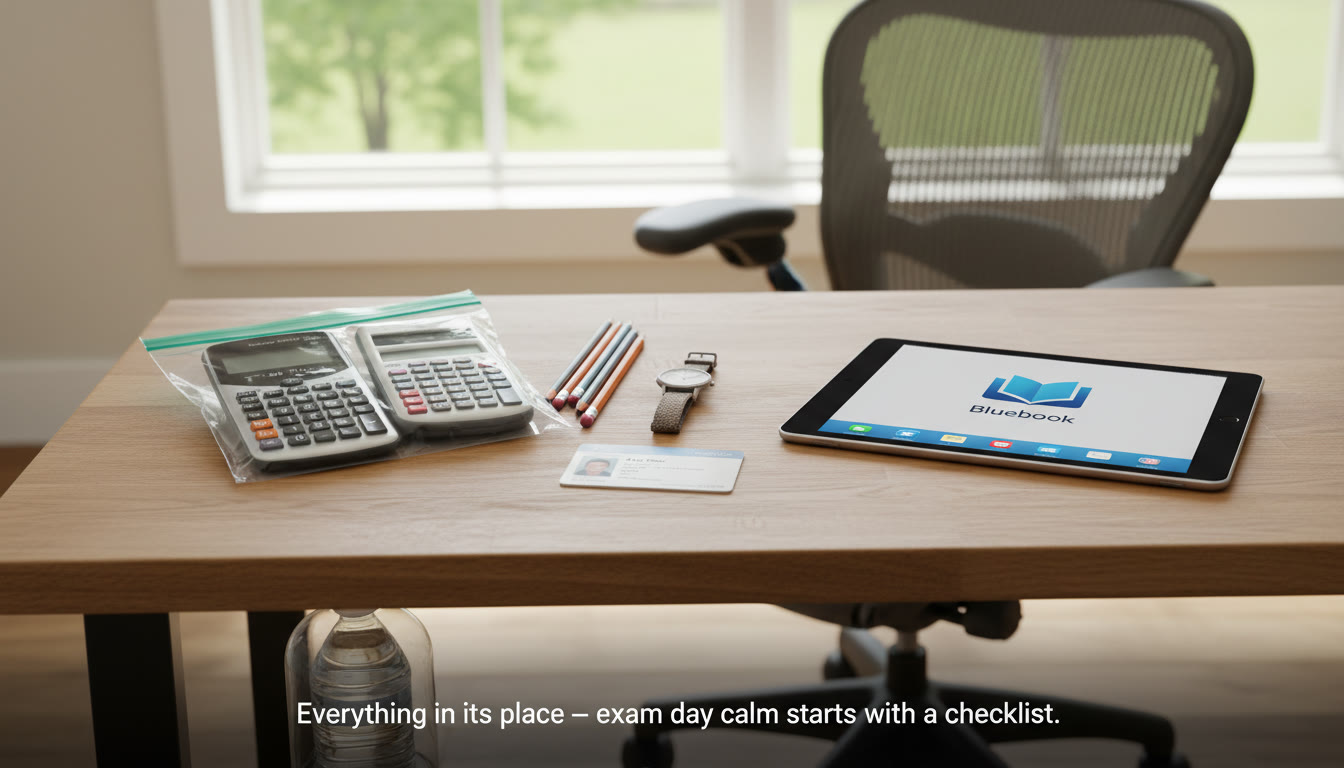
How to Use This List
Read the whole thing once, then create a one-page checklist to print or save on your phone. Personalize items for the format of your exam (paper vs. digital). If you’re working with a tutor or service like Sparkl, cross-check your list with your tutor — they’ll often suggest subject-specific additions and habits that match your study plan.
The Essentials — Items You Must Bring
These are the items the College Board explicitly expects students to have or asks students to consider bringing on exam day. If your exam is digital, note which items are required (for example, Bluebook sign-in details and a charged device). Put these in a small front pocket so you can access them quickly during check-in.
- Photo ID: A government-issued or school-issued photo ID if you are testing at a school you don’t attend. Keep it in a clear sleeve for fast presentation.
- Watch (non-smart): A simple analog or digital watch helps you manage time without relying on your phone. College Board permits a non-smartwatch; avoid anything with alarms or countdown beeps.
- Pencils and pens: For paper parts, bring 2–3 No. 2 pencils with erasers for multiple-choice sections and pens with black or dark blue ink for written responses where required. Mechanical pencils and No. 3 pencils are discouraged.
- Approved calculators (if allowed): For exams that permit calculators, bring up to two calculators you know well and that are on the approved list. If you’re taking a digital exam and plan to use Bluebook’s Desmos options, still consider bringing a familiar handheld calculator if allowed — it’s about comfort as much as policy.
- Fully charged testing device and charger: For students bringing their own device for digital exams, charge it fully and pack the charger or AC adapter. Include any required external keyboard (required for tablets on fully digital exams) or mouse as allowed.
- College Board account login info: You must be able to sign into Bluebook for digital exams. Memorize or securely store your username and password — saving a screenshot on a locked device can backfire if phones are banned during check-in.
Smart Comfort Items (Pack These, But Use Only When Allowed)
Comfort items can make a measurable difference in focus and stamina. Keep them subtle and unobtrusive. Some items are allowed only with prior approval (accommodations) — don’t assume special items will be permitted without SSD clearance.
- Layers of clothing: Testing rooms can be unpredictably warm or chilly. Pack a lightweight hoodie or zip-up so you can adjust without distracting others.
- Slip-on shoes: Easy to remove or shuffle in quiet moments — helpful during breaks or to relieve pressure after long sitting periods.
- Small silent fidget: Only bring if permitted; subtle, quiet items that help with concentration can be useful if they are allowed by your testing center.
- Medication and supplies: Any medication you need (in original packaging) and items tied to medical accommodations. If medication must be taken during the exam window, inform the proctor ahead of time and follow school protocols.
Food, Drinks, and Break Strategy
College Board policy generally prohibits food and drink inside the testing room unless you have an approved accommodation; however, you can usually leave the room during the short break between sections to get water or a snack with the proctor’s permission. Practice your break routine during mock tests: what snack refuels you without causing a sugar crash? Small, protein-rich bites are usually best.
What Not to Bring — Avoid These at All Costs
These prohibited items can get you dismissed from an exam or have your score canceled. The rules can vary slightly by format, so cross-check with your AP coordinator, but the following is a reliable baseline.
- Smartphones, smartwatches, or any wearable tech with connectivity.
- Extra electronic devices unless preapproved for exam delivery (and even then, only as specified).
- Books, notes, cheat sheets, calculators with prohibited features, and any subject-related clothing or hats that display formulas or study hints.
- Scratch paper — unless specifically provided by the testing center or the exam format allows it.
- Headphones, earplugs, or anything that covers ears (unless documented as an accommodation).
Special Notes by Exam Format
AP exams are offered in several formats — fully digital, hybrid digital, and traditional paper. Below is a compact comparison so you know how your packing changes depending on the format.
| Format | Must Bring | Typical Restrictions | Pack Tip |
|---|---|---|---|
| Fully Digital | Charged device with Bluebook, charger, external keyboard (if tablet), login info | No phones, no unauthorized external storage, one device only | Test your device with Bluebook ahead of time and carry a charger in a clear bag |
| Hybrid Digital | Device for digital portion, pencils/pens for paper booklet, charged battery | Different rules for each portion — follow proctor directions | Label which supplies are for digital vs. paper sections to avoid confusion |
| Paper (Traditional) | ID, watch, pencils, pens, approved calculator (if allowed) | No electronics, no scratch paper unless provided | Bring extra pencils and a trusty eraser; pre-sharpen if needed |
Calculator Guidance
If your AP course allows calculators — like Calculus AB/BC, Physics, or Chemistry — bring the calculator you’ve used during practice. For digital exam takers, Bluebook often supplies built-in Desmos calculators for specific exams; however, many students still prefer familiar handheld devices as backup. Do not assume Desmos will be available for every statistics or math exam — check your specific course rules. Before the exam, ensure your calculator batteries are fresh and that you know how to clear settings if needed. Remember: calculators may not be shared during the test.
Last-Minute Check: The Night Before
The night before the exam, do a “pack and practice” routine. Laying everything out reduces morning friction and gives your brain a calming ritual. Here’s a quick checklist you can run through an hour before bed.
- Charge phone (but place it in your bag’s outer compartment to leave at check-in or at home where rules require).
- Charge testing device and test Bluebook sign-in if possible.
- Polish your watch, sharpen pencils, and put an extra pencil/pen in the case.
- Pack ID and place it next to your keys and wallet.
- Lay out clothing for easy layering based on the forecast.
- Sleep strategy: plan to get 7–9 hours; even a small nap the afternoon before can help if you’re well-rested at night.
Morning of the Exam: Timing and Routine
Mornings are about ritual and pacing. Rushing increases adrenaline and reduces clarity. Start with a calm sequence that primes your focus.
- Eat a balanced breakfast — complex carbs plus protein (oatmeal with nuts, eggs and toast, Greek yogurt with fruit).
- Hydrate, but don’t overdo it. You’ll likely not be able to drink during test sections.
- Arrive 20–30 minutes early to account for parking, check-in, and those last-second nerves.
- Use the restroom before check-in; you’ll want to minimize interruptions during the test.
- Use sparingly rehearsed breathing exercises if you feel anxious — inhale for four counts, hold for four, exhale for six.
What to Do If Something Goes Wrong
If a calculator fails, a device malfunctions, or you forget something, stay calm and notify the proctor immediately. Proctors are trained to handle such situations and can provide solutions, from issuing spare materials to contacting exam coordinators. If a technical glitch affects a digital exam, document the time and what happened; your school’s AP Coordinator will handle the follow-up with College Board if needed.
Personalization: Subject-Specific Extras
Some AP subjects benefit from small, subject-specific items and mental hacks. Below are practical additions that don’t violate exam rules but can help your performance.
- AP Art and Design: Pack any pre-approved physical materials required for portfolio submission or in-class practicals as directed by your instructor. Confirm any hand-drawn or photographed evidence rules well in advance.
- AP Music Theory: Bring pencils and erasers you can use for notation; practice with the same pencil width you’ll use during the test.
- AP Languages: For tests requiring listening portions, check if your proctor will provide audio equipment. If your exam uses paper and requires handwritten responses, practice writing for speed and legibility.
- AP Calculus/Physics: Bring a reliable graphing calculator and extra batteries. During practice, simulate exam conditions including calculator use so you’re fluent in button sequences.
Small Tactical Moves That Yield Big Returns
Beyond items, a few tactical choices improve outcomes:
- Simulate exam conditions: Do practice tests under timed conditions using the same tools you’ll bring. Familiarity reduces surprises.
- Label everything: Put your name on devices and calculators in case items get misplaced during check-in.
- Check policies early: College Board updates policies from year to year for calculators and digital tools. Verify the current rules for your specific course well before exam week so you don’t pack the wrong tools.
- One small comfort: A soft breath mint or throat lozenge kept out of the testing room (for break use) can keep you comfortable if the room is dry.
How Tutors and Personalized Support Fit In
Working with a tutor can refine not just what you pack, but how you use those items effectively. If you’re using a service like Sparkl, leverage tutor time to rehearse the exact exam routine: practice with the same calculators, reproduce Bluebook login flows, and simulate time management with the watch you plan to bring. Personalized tutoring often helps students create tailored study plans — and tailor-made test-day checklists — that cut through guesswork and keep you focused on content mastery.
A Quick Mock Checklist to Print
Trim this down to a single printed sheet to tuck into your bag and glance at before you leave.
- ID in sleeve
- Non-smart watch
- 2–3 No. 2 pencils + eraser
- 2 pens (black/dark blue)
- Approved calculator(s) + fresh batteries
- Charged device for Bluebook + charger
- College Board login info memorized/securely saved
- Light jacket
- Medication (if needed)
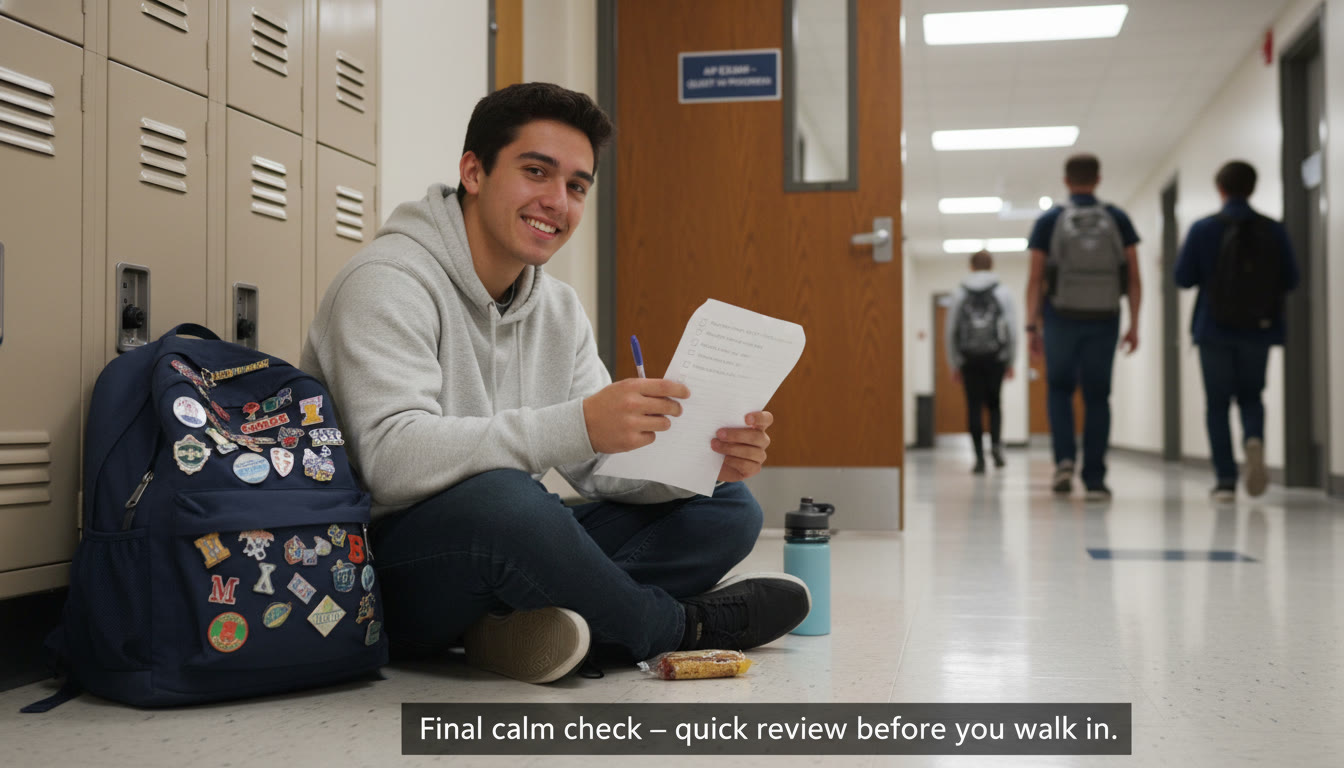
After the Exam: What to Keep in Your Bag
After the final question, take a brief mental cooldown. Use the time to reflect — not on which answers you might have missed, but on what you learned about pacing and preparation. If you worked with a tutor or Sparkl’s personalized plan, note one or two things to tweak for future tests: time management, calculator fluency, or reading strategies. This reflective habit is surprisingly effective for continuous improvement.
Final Words: Calm, Prepared, and Confident
AP exam day is a test of knowledge — and a test of preparation. The items you pack are small: a watch, pencils, an approved calculator, an ID, a charged device for Bluebook. What matters more is the ritual behind them. Pack the night before, practice with the tools you’ll use, learn the policies for your specific AP course, and leave a buffer for the unexpected. If you’d like extra reassurance, work through one or two mock exam days with a tutor who knows AP protocols; personalized tutoring can remove uncertainty and replace it with reliable habits. Walk into the testing room knowing you did everything possible to be ready — that’s where real confidence begins.
Good luck — you’ve put in the work. Now pack well, breathe, and show up for yourself.





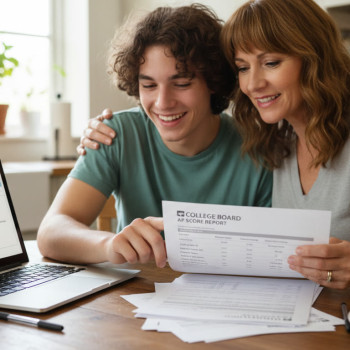
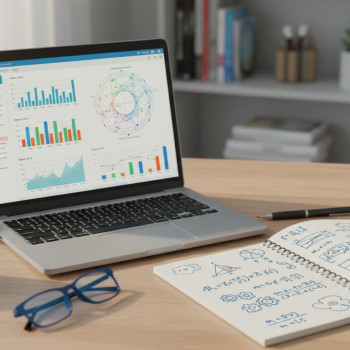
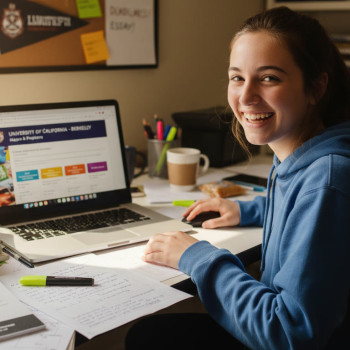
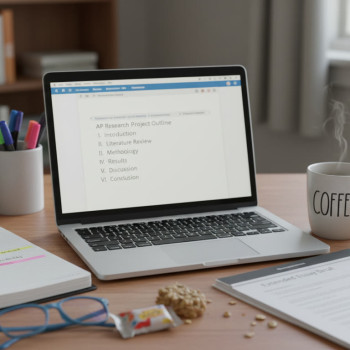















No Comments
Leave a comment Cancel